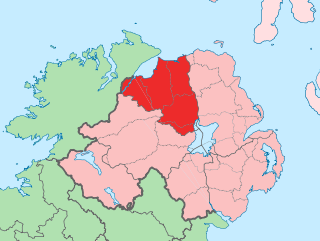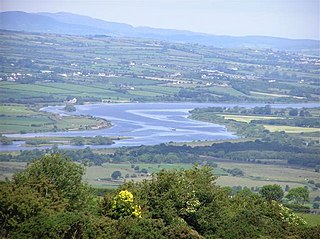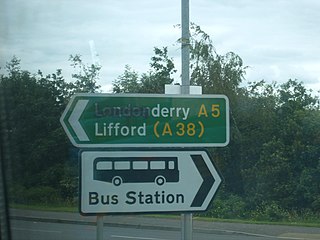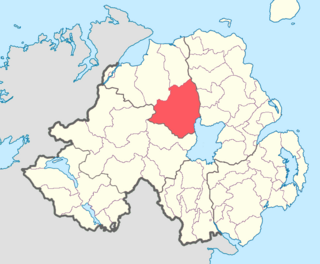
Derry, officially Londonderry, is the largest city in County Londonderry, the second-largest in Northern Ireland and the fifth-largest on the island of Ireland. The old walled city lies on the west bank of the River Foyle, which is spanned by two road bridges and one footbridge. The city now covers both banks.

County Londonderry, also known as County Derry, is one of the six counties of Northern Ireland, one of the thirty-two counties of Ireland and one of the nine counties of Ulster. Before the partition of Ireland, it was one of the counties of the Kingdom of Ireland from 1613 onward and then of the United Kingdom after the Acts of Union 1800. Adjoining the north-west shore of Lough Neagh, the county covers an area of 2,118 km2 (818 sq mi) and today has a population of about 252,231.

The Worshipful Company of Drapers is one of the 111 livery companies of the City of London. It has the formal name The Master and Wardens and Brethren and Sisters of the Guild or Fraternity of the Blessed Mary the Virgin of the Mystery of Drapers of the City of London. More usually known simply as the Drapers' Company, it is one of the historic Great Twelve Livery Companies and was founded during the Middle Ages.

Coleraine is a town and civil parish near the mouth of the River Bann in County Londonderry, Northern Ireland. It is 55 miles (89 km) northwest of Belfast and 30 miles (48 km) east of Derry, both of which are linked by major roads and railway connections. It is part of Causeway Coast and Glens district.

The Plantation of Ulster was the organised colonisation (plantation) of Ulster – a province of Ireland – by people from Great Britain during the reign of King James VI and I. Most of the settlers came from southern Scotland and northern England; their culture differed from that of the native Irish. Small privately funded plantations by wealthy landowners began in 1606, while the official plantation began in 1609. Most of the land had been confiscated from the native Gaelic chiefs, several of whom had fled Ireland for mainland Europe in 1607 following the Nine Years' War against English rule. The official plantation comprised an estimated half a million acres (2,000 km2) of arable land in counties Armagh, Cavan, Fermanagh, Tyrone, Donegal, and Londonderry. Land in counties Antrim, Down, and Monaghan was privately colonised with the king's support.

The Ulster Transport Authority (UTA) ran rail and bus transport in Northern Ireland from 1948 until 1966.

The River Foyle is a river in west Ulster in the northwest of the island of Ireland, which flows from the confluence of the rivers Finn and Mourne at the towns of Lifford in County Donegal, Republic of Ireland, and Strabane in County Tyrone, Northern Ireland. From here it flows to the city of Derry, where it discharges into Lough Foyle and, ultimately, the Atlantic Ocean. The total length of the River Foyle is 32 km (20 mi). The river separates part of County Donegal from parts of both County Londonderry and County Tyrone. The district of County Donegal that borders the western bank of the River Foyle is traditionally known as the Laggan. This district includes the villages of St Johnston and Carrigans, both of which are nestled on the banks of the River.

The names of the city and county of Derry or Londonderry in Northern Ireland are the subject of a naming dispute between Irish nationalists and unionists. Generally, although not always, nationalists favour using the name Derry, and unionists Londonderry. Legally, the city and county are called "Londonderry", while the local government district containing the city is called "Derry City and Strabane". The naming debate became particularly politicised at the outset of the Troubles, with the mention of either name acting as a shibboleth used to associate the speaker with one of Northern Ireland's two main communities. The district of Derry and Strabane was created in 2015, subsuming a district created in 1973 with the name "Londonderry", which changed to "Derry" in 1984.
A county corporate or corporate county was a type of subnational division used for local government in England, Wales, and Ireland.

Northern Ireland is divided into six counties, namely: Antrim, Armagh, Down, Fermanagh, Londonderry and Tyrone. Six largely rural administrative counties based on these were among the eight primary local government areas of Northern Ireland from its 1921 creation until 1973. The other two local government areas were the urban county boroughs of Derry and Belfast.

Loughinsholin is a barony in County Londonderry, Northern Ireland. Its southeast borders the northwest shore of Lough Neagh, and itself is bordered by seven other baronies: Dungannon Upper to the south; Strabane Upper to the west; Keenaght and Coleraine to the north; Kilconway, Toome Upper, and Toome Lower to the east. It was formed largely on the extent of the northern part of the medieval Irish túath of Uí Tuirtri.

The North West Liberties of Londonderry is a barony in County Londonderry, Northern Ireland. It is bordered by two other baronies in Northern Ireland: Tirkeeran to the east, across Lough Foyle, and Strabane Lower to the south. It also borders two baronies in County Donegal in the Republic of Ireland. It borders Raphoe North, to the south-west; and Inishowen West to the north.
Events from the year 1613 in Ireland.
The Londonderry Borough Police was the police force in the city of Derry, County Londonderry, Ireland, from 1848 to 1870, nicknamed the Horney Dicks after the bones used in their helmets. They replaced the earlier town watch and were in turn replaced by the Royal Irish Constabulary (RIC). The police force was established by the Londonderry Improvement Act 1848 and were governed by the Londonderry Corporation. Its abolition was recommended by a royal commission of inquiry into sectarian riots in the city in 1869. The commission felt the force, having the form of a town watch, was inadequate to policing serious crime; it also noted, but did not endorse, allegations that the police discriminated against Roman Catholics.
Sir Thomas Phillips (1560–1633) was an English knight and soldier of fortune. He was knighted in 1607. Originally granted land at Coleraine, Ulster, Kingdom of Ireland, he forfeited it to the London Livery Companies in exchange for grants of land at Limavady and what became the Moyola estate as part of the Plantation of Ulster. In 1622 he sold the Moyola estate to Thomas Dawson. A son, Sir Dudley Phillips, was a key figure in the defence of Coleraine and Londonderry during the 1641 Rebellion.

Derry's walls were originally built by the Irish Society between 1613 and 1619, under the supervision of the London builder and architect Peter Benson. They were built with the intention of protecting the Scottish and English planters that had moved to Ulster as part of the Plantation of Ulster that had been established by James I. It was a direct consequence of the previous settlement being destroyed by Irish chieftain Cahir O'Doherty during O'Doherty's rebellion. As a result of the building of the city's defences by the Irish Society, which was a consortium of livery companies based out of the City of London, the city was officially renamed Londonderry in the 1613 royal charter. This is what has subsequently led to the naming dispute for the city and county of Derry/Londonderry.
Donnell Ballagh O'Cahan was an Irish landowner in Ulster. A vassal of Hugh O'Neill, Earl of Tyrone, O'Cahan was frequently in rebellion alongside his lord in the closing years of the 16th century. Although he did not go into exile with Tyrone, he claimed to have been betrayed by the English Crown, which he accused of failing to keep to an agreement over a large grant of lands. Arrested for treason, he was never brought to trial but was held captive in Tower of London until his death sometime around 1627.
The 1860 Londonderry City by-election was held on 2 April following the 13 March 1860 death of the incumbent, the Liberal Party's Sir Robert Ferguson. Ferguson had held the seat since 1830 and had received significant support from the Catholic segment of the constituency. The Liberal Party's candidate Samuel MacCurdy Greer had counted on this support transferring to him, however the Irish Conservative Party's candidate William McCormick, who employed a significant number of Catholic workers, managed to split the Catholic vote. The Liberal Party's Presbyterian support had also been adversely affected by their defeat to the Tories in Londonderry County in 1857, which led many to withdraw from politics.
Boom Hall is a house and demesne in Derry, Northern Ireland. Lying close to the west bank of the River Foyle, a fort was constructed on the site during the English Civil War. During the Williamite War in Ireland a boom was constructed across the river to try to prevent Williamite forces relieving the Siege of Derry. A two-storey country house was subsequently built on the site by the Alexander family and named after this boom. The estate was later leased to a number of people until a leasehold was sold to Daniel Baird in 1849 by The 3rd Earl of Caledon. This was inherited by Daniel Baird Maturin-Baird who also purchased the freehold from the Alexanders. Boom Hall was again let to a number of different people, with Michael Henry McDevitt living there from 1924. During the Second World War, the demesne was used by the Admiralty and a number of temporary huts were built there. McDevitt purchased the freehold in 1949 and the house was renovated. It fell into disuse in the 1960s and was almost destroyed by fire in the 1970s. Part of the estate was used for the construction of the Foyle Bridge.
George Downing (1584–c.1659) was a pioneer English settler in County Londonderry during its plantation by the Livery Companies of the City of London. He was Sheriff of Derry during the 1620s and a member of the Parliament of Ireland in 1634.













